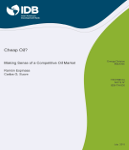Cheap Oil? Making Sense of a Competitive Oil Market
Date
Jul 2015
This technical note discusses the changes in the price of crude oil that occurred in the second half of 2014 and the price dynamics of the first half of 2015. It shows that from 2011 till the first half of 2014 the price of crude oil remained at a remarkably stable level around 100 dollars per barrel, while prices for other commodities were falling as a result of declining demand, particularly in emerging markets. We argue that the resiliency of crude oil prices between 2011 and 1H2014 was a result of deliberate action by Saudi Arabia and other Gulf Cooperation Council (GCC) producers to keep the price of oil stable at a level perceived to be competitive by intervening in the market when the price diverged too far from an established level. Saudi Arabia and the GCC compensated three major supply disruptions by increasing production to prevent prices remaining above the 100 dollars per barrel mark for long. Beyond stabilizing prices, the strategy aimed at maintaining Saudi production competitive, increasing its world market share. Our research finds that the recent and sharp decline in price, a result of increased production from the United States tight oil basins, has led GCC to emphasize its market share strategy by increasing production at the new price level to bring United States shale production increase to a halt. Indeed, this means that the price of crude oil will be set at the marginal price of production of non-conventional crudes in the United States, a characteristic found in competitive markets and heretofore missing from the crude oil market.




